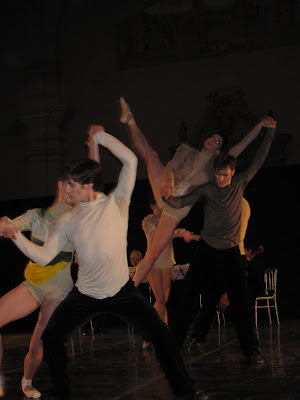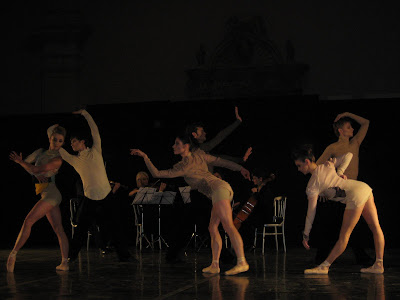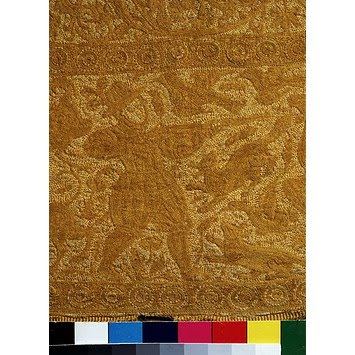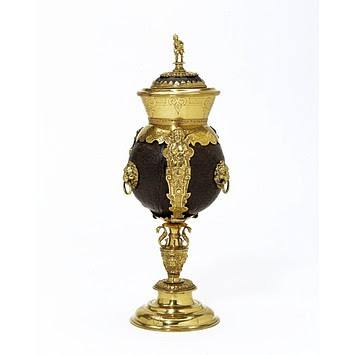Sunday 5 December 2010
LCF Fashion show
Here are a few images of a fashion show by LCF held at the V&A. It was a culmination in a two year project with the BA Fashion students and the museum drawing on influences from the Ballets Russes. The highlight of the evening was an incredible live ballet performance by the English National ballet accompanied by an orchestra. The dancers wore some students' costumes.







Trade between East and West- V&A
'God is as everlasting as the dyed textiles of India'
A recent Friday theory excursion to the South Asian and British galleries with historian Clare Rose was a thoroughly interesting experience and gave me incredible insight into the strong influence of the east. It appears Indian textiles have been around since the year dot.In the year 700 in a written Bible the question 'How wise is God?' was posed. The Catholic church replied with a metaphor translated as 'God is as everlasting as the dyed textiles of India'. Incredible! The V&A displays a selection of medieval Indian textiles found in an Egyptian rubbish tip around 1300, and still in a beautiful yet extremely fragile condition. Indian textiles were of high quality and remarkable skill.

This stunning yellow coverlet embroidered with silk thread from special silk worms only found in Bengal displays the coat of arms of a Portuguese family. Indian bedcovers were seen as a prized possession in Europe and therefore many Indian hand crafted goods were destined for the western market.
This handspun muslin gown, once again embroidered in Bengal has the unmistakable design of a British 'Jane Austen' style couture dress. Once again, designed in Europe, made in India.

As well as textiles, other Indian goods such as jewelry were imported in the 1850s to show and inform British students on 'good design'.

One thing I found particularly fascinating was the emergence of 'Bizzare Style' in high fashion during the period 1700-1720. It is basically a Chintz hand painted in India with a mishmash of design references, e.g. peonies and pegodas' from China alongside Turkish tulips.
Another interesting concept which arose took me back to our initial Rough Guide project. We had to write about three objects- one found or second hand, one from a shop and one from a museum and discuss how placing them in a different context altered our perceptions of them. In the British galleries, many items convey this concept. For example a cheap Chinese ceramic bowl, probably considered to be a common and worthless everyday item in China has been perceived by the west as an item of extreme beauty and value and thus gold handles and a gold lit has been added to the bowl. Take an item out of its everyday surroundings and it gains a whole new identity. One of the strangest examples of this is the gold mounted coconut cup-

As such a rarity in the West, the coconut must have been seen as extremely exotic and desirable. I for one will never look at a coconut in the same way!
A recent Friday theory excursion to the South Asian and British galleries with historian Clare Rose was a thoroughly interesting experience and gave me incredible insight into the strong influence of the east. It appears Indian textiles have been around since the year dot.In the year 700 in a written Bible the question 'How wise is God?' was posed. The Catholic church replied with a metaphor translated as 'God is as everlasting as the dyed textiles of India'. Incredible! The V&A displays a selection of medieval Indian textiles found in an Egyptian rubbish tip around 1300, and still in a beautiful yet extremely fragile condition. Indian textiles were of high quality and remarkable skill.
This stunning yellow coverlet embroidered with silk thread from special silk worms only found in Bengal displays the coat of arms of a Portuguese family. Indian bedcovers were seen as a prized possession in Europe and therefore many Indian hand crafted goods were destined for the western market.
This handspun muslin gown, once again embroidered in Bengal has the unmistakable design of a British 'Jane Austen' style couture dress. Once again, designed in Europe, made in India.
As well as textiles, other Indian goods such as jewelry were imported in the 1850s to show and inform British students on 'good design'.
One thing I found particularly fascinating was the emergence of 'Bizzare Style' in high fashion during the period 1700-1720. It is basically a Chintz hand painted in India with a mishmash of design references, e.g. peonies and pegodas' from China alongside Turkish tulips.
Another interesting concept which arose took me back to our initial Rough Guide project. We had to write about three objects- one found or second hand, one from a shop and one from a museum and discuss how placing them in a different context altered our perceptions of them. In the British galleries, many items convey this concept. For example a cheap Chinese ceramic bowl, probably considered to be a common and worthless everyday item in China has been perceived by the west as an item of extreme beauty and value and thus gold handles and a gold lit has been added to the bowl. Take an item out of its everyday surroundings and it gains a whole new identity. One of the strangest examples of this is the gold mounted coconut cup-
As such a rarity in the West, the coconut must have been seen as extremely exotic and desirable. I for one will never look at a coconut in the same way!
Saturday 4 December 2010
Design Museum Fashion talks
Hywel Davies interviewing the flamboyantly dressed Fred Butler.
The 'Sparkle the Dark up' event at the Design Musuem although not particularly sparkly, was nonetheless pretty interesting. Hywel Davies, author of 'Fashion Designers' Sketchbooks' gave 4 key contemporary fashion figures a real grilling- Richard Nicoll, Fred Butler, Bora Asku and Amy Moleyaux from PPQ. A key point raised by each of the designers and which seems to be a reoccuring theme in every talk/ exhibition I visit is the importance of collaboration. Fashion designers are increasingly looking to join forces with artists, filmakers, musicians, choreographers etc. Fred Butler, a remarkably subdued character in contrast with her crazy otherworldly accessories talked about her love of learning old crafts from second hand books and then applying them to synthetic materials. She described her USP (Unique selling product) by the fact that her creations perplex people and they aren't able to figure out how she has made them. Bora Asku gave a plug to carboot sales in Vauxhall and Portabello as highly inspirational places to visit. Finally, Amy Moleyeux defined the key features of the PPQ brand with the words 'dresses, surface decoration and print'. Looking at the S/S11 Collection and this is easy to see-
Designs are feminine, bold, modern and fresh.
The exhibition at the Museum - 'Drawing Fashion' was a beautiful, highly elegant collection of remarkable fashion illustrations from the twentieth and twenty first centuries. I particularly liked some of the alternative approaches to drawing and am keen to discover more about 'monotyping', a process which unlike monoprinting, removes ink to create an image. See below.
Francois Berthoud, Comme des Garcons
Vogue, Japan 2001
Linocut, monotype and collage.
Subscribe to:
Posts (Atom)
